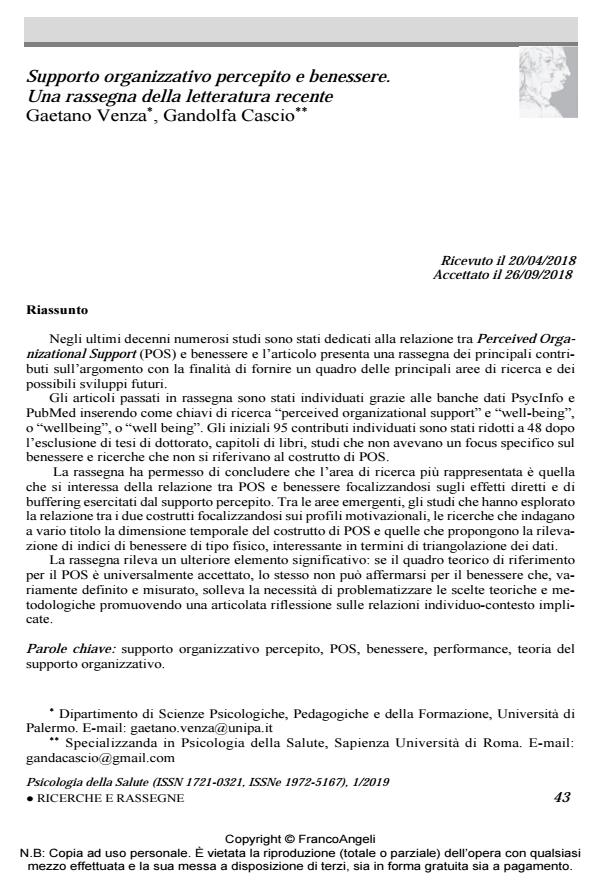Supporto organizzativo percepito e benessere. Una rassegna della letteratura recente
Titolo Rivista PSICOLOGIA DELLA SALUTE
Autori/Curatori Gaetano Venza, Gandolfa Cascio
Anno di pubblicazione 2019 Fascicolo 2019/1
Lingua Italiano Numero pagine 21 P. 43-63 Dimensione file 279 KB
DOI 10.3280/PDS2019-001003
Il DOI è il codice a barre della proprietà intellettuale: per saperne di più
clicca qui
Qui sotto puoi vedere in anteprima la prima pagina di questo articolo.
Se questo articolo ti interessa, lo puoi acquistare (e scaricare in formato pdf) seguendo le facili indicazioni per acquistare il download credit. Acquista Download Credits per scaricare questo Articolo in formato PDF

FrancoAngeli è membro della Publishers International Linking Association, Inc (PILA)associazione indipendente e non profit per facilitare (attraverso i servizi tecnologici implementati da CrossRef.org) l’accesso degli studiosi ai contenuti digitali nelle pubblicazioni professionali e scientifiche
Negli ultimi decenni numerosi studi sono stati dedicati alla relazione tra Perceived Or-ganizational Support (POS) e benessere e l’articolo presenta una rassegna dei principali con-tributi sull’argomento con la finalità di fornire un quadro delle principali aree di ricerca e dei possibili sviluppi futuri. Gli articoli passati in rassegna sono stati individuati grazie alle banche dati PsycInfo e PubMed inserendo come chiavi di ricerca "perceived organizational support" e "well-being", o "wellbeing", o "well being". Gli iniziali 95 contributi individuati sono stati ridotti a 48 dopo l’esclusione di tesi di dottorato, capitoli di libri, studi che non avevano un focus specifico sul benessere e ricerche che non si riferivano al costrutto di POS. La rassegna ha permesso di concludere che l’area di ricerca più rappresentata è quella che si interessa della relazione tra POS e benessere focalizzandosi sugli effetti diretti e di buffering esercitati dal supporto percepito. Tra le aree emergenti, gli studi che hanno esplorato la relazione tra i due costrutti focalizzandosi sui profili motivazionali, le ricerche che indagano a vario titolo la dimensione temporale del costrutto di POS e quelle che propongono la rilevazione di indici di benessere di tipo fisico, interessante in termini di triangolazione dei dati. La rassegna rileva un ulteriore elemento significativo: se il quadro teorico di riferimento per il POS è universalmente accettato, lo stesso non può affermarsi per il benessere che, va-riamente definito e misurato, solleva la necessità di problematizzare le scelte teoriche e me-todologiche promuovendo una articolata riflessione sulle relazioni individuo-contesto impli-cate.
Parole chiave:Supporto organizzativo percepito, POS, benessere, performance, teoria del supporto organizzativo.
- Associations of Job Insecurity With Perceived Work-Related Symptoms, Job Satisfaction, and Turnover Intentions: The Mediating Role of Leader–Member Exchange and the Moderating Role of Organizational Support Giovanni Di Stefano, Gaetano Venza, Davide Aiello, in Frontiers in Psychology 1329/2020
DOI: 10.3389/fpsyg.2020.01329
Gaetano Venza, Gandolfa Cascio, Supporto organizzativo percepito e benessere. Una rassegna della letteratura recente in "PSICOLOGIA DELLA SALUTE" 1/2019, pp 43-63, DOI: 10.3280/PDS2019-001003